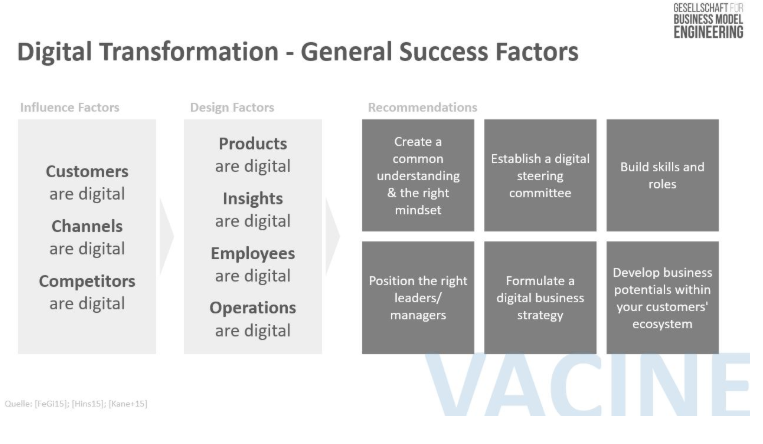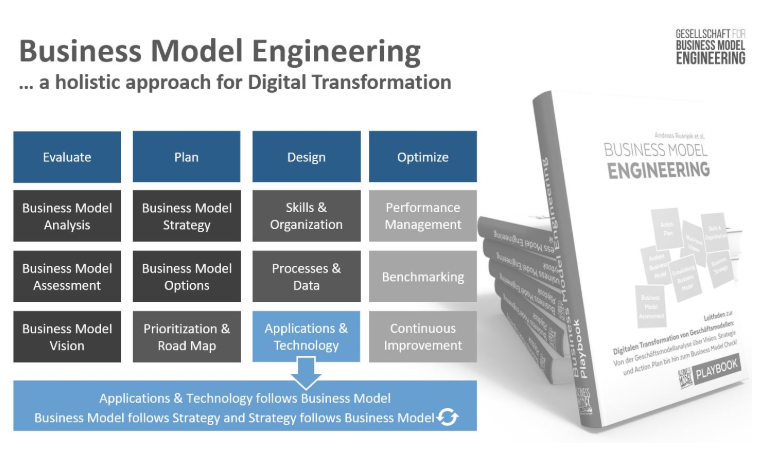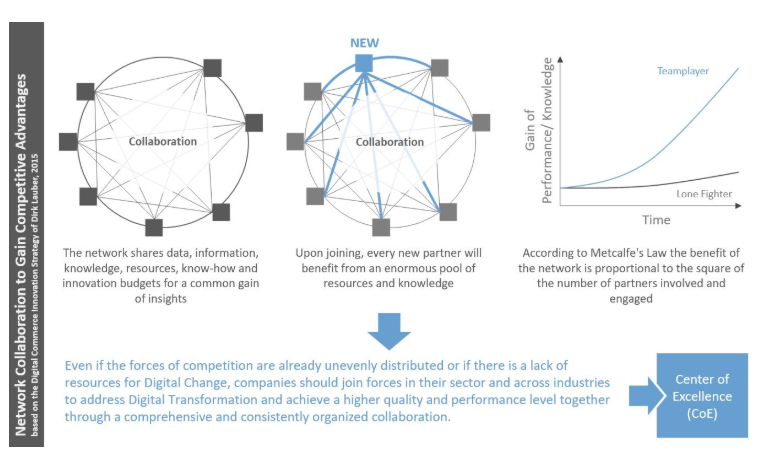The digitalization of data and processes combined with delivery of excellent customer benefit along with digitized information and communication architecture will be an increasingly important developing a digital innovation strategy in the years ahead. New business models are needed to consolidate or expand a company’s market position. The way how new business models evolve depends to a large extent on how companies adapt their established value-added processes and structures to environmental changes and on how they face competition. Having a clear strategy and a purposeful, structured process for implementing new business models and/ or gradually adapting existing ones to new business models will determine the success of digital transformation projects and a company’s market position.
Companies, regardless of whether they are a start-up, an SME or a large corporation, need to address the following questions:
How to Start?
First and foremost, it is vital not to view digital transformation as a fleeting trend that can be addressed by a single project and/ or measure to eliminate weak points or leverage potentials, for example. Rather, within your company, it’s crucial to understand digital transformation as a platform ecosystem that establishes the needed conditions for a successful digitalization. Examples for improvements could be changes in your organization, in the leadership, directly in the value chain, in the value-adding network with partners or at the interfaces to the customers or to partners.
→ Free Download: 6 Steps to digitize your Business

The figure above points out general success pillars of digital transformation. Accepting that every factor of a company (customer, employees, products, etc.) are digital, it derives certain recommendations. Your task, starting with the management levels, will be to ensure a common understanding about the need for digital transformation as well as the right mindset. You have to establish the basic conditions for incremental and radical transformation through an internal platform that fosters experimenting and explicitly permits making mistakes. The latter provides valuable insights and experiences which can, in turn, be leveraged. Another recommendation is to create a digital steering committee made of motivated, interested and experienced employees (of all ages and hierarchy levels), institutionalize it and establish an adequate communication strategy for the entire company. This will challenge your company’s culture and its willingness to embrace change.
Transform your corporate culture slowly but steadily and involve all stakeholders, expand the roles and the skill portfolio of your employees, in particular. In this process, acknowledge critical opinion; take concerns and reservations seriously, and try to ease them. The key success factor of your company is and remains the human factor in the form of your employees, stakeholders, and shareholders. Recommendations also concern to taking control of your leadership positioning, leveraging the potential of the customers and, of course, all the above-mentioned steps should be supported by a sustainable business strategy.
You can orient yourself in terms of taking the right measures for digital transformation by VACINE paradigm which provides a framework for companies in scopes of VUCA (Volatility, Uncertainty, Complexity, Ambiguity) fluid strategies. As a result, you can develop resulting fields of action.
VACINE stands for
- V = Velocity: Companies need to keep the pace faster and faster in the market ecosystem.
- A = Agility: Agility stands for the ability to be flexible, proactive and ready for continuous market change and transformation in order to adequately react.
- C = Creativity: Your ability to harness creativity will create your competitive advantage in today’s extremely dynamic environment.
- I = Innovation: Ability of a company to be competitive in a dynamic market environment in a sustainable and differentiating manner and to be able to maintain or expand business models.
- N = Network: In the future, those companies will be successful that can leverage their network environments to build an ecosystem where customers play the central role.
- E = Experimentation: Fast pace on the markets require a culture of experimentation. This helps to quickly transform business models in a target-oriented manner (aligned to actions and their resulting experiences).
How to Develop a Clear Strategy in the Context of Digital Transformation?
Together with your digital steering committee and other executives you should determine your company’s position in particular with regard to its own expectations (strategic goals, market positioning/ competition) and the perception of your (key) customers. Identify its current weaknesses and risks by gaining a clear picture of important (technological) trends and their effects on society, business, and legislation. Use these insights to challenge your business model(s) keeping a focus on their sustainability, existing strengths, potential opportunities, (untapped) optimization potentials and possible synergic prospects resulting from digitalization. Use these processes as a basis to derive a vision, an overriding corporate goal like, for example, where your company is to stand with regard to the market, customer perception, etc. within the next X years. You should develop all these aspects in cooperation with your managers and use the digital steering committee as a central, or additional, influencing factor to achieve your corporate goals by having the committee propose matching (sub-) strategies based on your vision.
How to Successfully Implement New Business Models?
Based on your (sub-) strategies you can develop business model options which have to be checked for their market viability in a lean and agile manner. The most promising options are then prioritized based on adequate criteria and translated into a roadmap which can be used to plan and manage the project implementation. This can be done in parallel to your daily business or as an integrated part of daily business. Based on this roadmap, which represents the actual starting point of the digital transformation, you then identify potential gaps and/ or needs with a view to the skills/ roles, processes, tools, and data as well as applications and/ or technologies needed. Once you have a clear picture, you start planning the required measures in the form of corresponding projects and then initiating the transformation process. Here, a good change management and adequate leadership are essential.
How to Achieve a Sustainable Digital Transformation?
Digital transformation happens permanently in ever shorter cycles. You should not view the above-described measures as a one-time process but as a continually recurring program or cycle. You should regularly challenge its results and/ or the performance of your business models by means of a comprehensive performance management as well as an adequate reporting and you should benchmark your company within your sector and across industries. Create room for continuous improvement by way of a continually recurring mechanism. Potentials identified in the performance management and/ or benchmarking process should be returned to your organization via the continuous improvement process.
As a procedure model, Business Model Engineering addresses the four questions (1 through 2) listed at the beginning by providing a structured framework for a successful and sustainable digital transformation. Despite the predefined structures and methods, the goal is to retain some room for creativity and agility in those fields where it is needed.
Digital transformation can thus be broken down into the four fields of action
- Evaluate
- Plan
- Design
- Optimize
and into the three disciplines
- Business Model Innovation
- Business Model Transformation
- Business Model Health Check
Each field of action is composed of three individual phases (see figure below). This framework was developed based on practical corporate experience in line with studies carried out by McKinsey & Company, Harvard Business Review, MIT Sloan, Stanford, Strategy& as well as a cooperation with analysts from Forrester Research and the Gartner Group.

Below are the questions from the outset and the respective disciplines that they address.
The question “How to start?” refers to Business Model Innovation.
The questions “How to arrive at a clear strategy in the context of digital transformation?” and “How to successfully implement new business models?” drive Business Model Transformation
The last question “How to achieve a sustainable digital transformation?” focuses on Business Model Health Check.
Successful transformations are preceded by innovative thoughts, technologies, trends or simply corporate needs and customer demands. This does not necessarily lead to new developments in the technological, organizational or social sense, but could simply refer to existing conditions that merely have a novel character for your company or your organization and require a purposeful implementation. That is why, in addition to the strategy and the culture, also Innovation Management and Change Management play a very important role. In this context, innovations can be found at all departments and implemented to the benefit of the company, e.g. in your organization, the management, product development, marketing, sales, production/ logistics or services provided, together with partners or competitors. As a procedure model, Business Model Engineering supplements your strategic innovation management in the same way as it already includes elements of strategic innovation management which are basically almost congruent with many approaches used by ITONICS.
If you believe that your company does not have the resources required to sustainably address digital change or digital transformation, or if you would like to further invest to stay ahead of continual market disruption, then you should consider innovation and transformation networks. You contribute your ideas and competencies to a network and – besides the cost advantages – benefit in particular from the exchange within the network and from the contributions from other network participants. The figure below highlights the benefits of network effects for competitive advantage.
Together with ITONICS, I will gladly assist you if you have any further questions or if you are looking for cooperation.

 Andreas Rusnjak is a professor for Strategic Innovation Management and Digital Economy at the Flensburg University of Applied Sciences. In parallel with academic work, he advises and assists companies in the fields of digital transformation, strategic innovation management, digital commerce, customer experience management, etc. His PhD focuses on methods for business model transformation. In the last five years before joining the university as a professor, he worked as Head of Business Engineering in at one of the largest German online shops operated by Otto Group.
Andreas Rusnjak is a professor for Strategic Innovation Management and Digital Economy at the Flensburg University of Applied Sciences. In parallel with academic work, he advises and assists companies in the fields of digital transformation, strategic innovation management, digital commerce, customer experience management, etc. His PhD focuses on methods for business model transformation. In the last five years before joining the university as a professor, he worked as Head of Business Engineering in at one of the largest German online shops operated by Otto Group.
References
- Fenwick, N.; Gill, M.: Unleash Your Digital Predator. Forrester Research, Report 2015
- Hinssen, P.: The network always wins. How to influence customers, stay relevant, and transform your organization to move faster than the market. McGraw-Hill, New York, NY, 2015
- Kane, G. C. et al.: Strategy, Not Technology, Drives Digital Transformation. MITSloan Review, 2015


/Assets%20and%20Heros/nav-thumbnail-Gartner.webp?width=150&name=nav-thumbnail-Gartner.webp)









